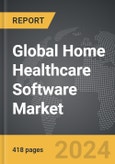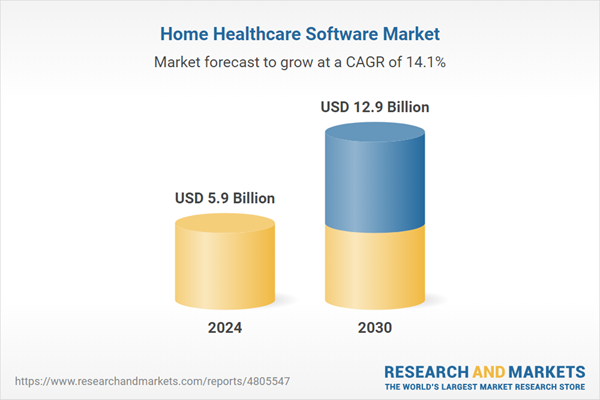The global market for Home Healthcare Software was valued at US$5.9 Billion in 2024 and is projected to reach US$12.9 Billion by 2030, growing at a CAGR of 14.1% from 2024 to 2030. This comprehensive report provides an in-depth analysis of market trends, drivers, and forecasts, helping you make informed business decisions. The report includes the most recent global tariff developments and how they impact the Home Healthcare Software market.
Segments: Component (Solutions, Services).
Geographic Regions/Countries: World; USA; Canada; Japan; China; Europe; France; Germany; Italy; UK; Rest of Europe; Asia-Pacific; Rest of World.
The analysts continuously track trade developments worldwide, drawing insights from leading global economists and over 200 industry and policy institutions, including think tanks, trade organizations, and national economic advisory bodies. This intelligence is integrated into forecasting models to provide timely, data-driven analysis of emerging risks and opportunities.
Global Home Healthcare Software Market - Key Trends & Drivers Summarized
What Is Home Healthcare Software and How Is It Changing Care Delivery?
Home healthcare software encompasses a broad range of platforms designed to manage, coordinate, and document the provision of medical care at patients' homes. This software supports a variety of functions, including patient scheduling, treatment planning, staff management, billing, and compliance with healthcare regulations. With the growing trend of aging populations preferring to stay in their own homes, coupled with advances in mobile technology, home healthcare software is becoming increasingly vital for ensuring that patients receive efficient and effective care. These systems not only streamline administrative tasks for care providers but also enhance the accuracy of clinical documentation, improve patient outcomes through better care coordination, and ensure compliance with health insurance policies and governmental regulations.How Are Technological Advancements Influencing Home Healthcare Software?
The continuous evolution of technology plays a critical role in the development of home healthcare software. With the integration of AI and machine learning, these platforms are becoming more sophisticated in predicting patient risks and suggesting preventive measures tailored to individual health profiles. Moreover, the incorporation of telehealth functionalities has revolutionized patient-provider interactions, enabling real-time communication and remote monitoring capabilities that extend the reach of medical professionals beyond traditional settings. This technology allows for the continuous monitoring of patients’ health statuses through wearable devices that can send alerts and updates directly to healthcare providers via the software, thus facilitating immediate interventions when necessary.Who Benefits from Home Healthcare Software?
The primary beneficiaries of home healthcare software are the elderly, patients with chronic conditions, and those requiring post-operative care, who can receive high-quality medical treatment in the comfort of their own homes. Additionally, healthcare providers benefit from the enhanced efficiency and reduced paperwork provided by these solutions. Home healthcare agencies find these systems particularly valuable for coordinating care among multiple caregivers and ensuring that treatment plans are followed accurately and effectively. On a larger scale, insurance companies and governmental healthcare agencies also benefit from the detailed and accurate reporting capabilities of home healthcare software, which help streamline the billing process and ensure compliance with health regulations.What Drives the Growth in the Home Healthcare Software Market?
The growth in the home healthcare software market is driven by several factors, including technological advancements, the aging global population, and increasing healthcare costs. The advancements in cloud computing and mobile technologies have made home healthcare software more accessible and scalable, enabling providers to deploy these solutions more efficiently across geographically dispersed regions. The global increase in the aging population has created a substantial demand for healthcare services that can be delivered at home, making software solutions that offer effective management and coordination of care highly desirable. Additionally, as healthcare costs continue to rise, there is a growing emphasis on reducing hospital readmission rates and managing chronic diseases effectively at home, which further drives the adoption of this technology. Consumer behavior trends toward more personalized and convenient healthcare solutions also contribute to this growth, as patients increasingly seek services that can be tailored to their individual needs and delivered directly to their homes.Report Scope
The report analyzes the Home Healthcare Software market, presented in terms of units. The analysis covers the key segments and geographic regions outlined below.Segments: Component (Solutions, Services).
Geographic Regions/Countries: World; USA; Canada; Japan; China; Europe; France; Germany; Italy; UK; Rest of Europe; Asia-Pacific; Rest of World.
Key Insights:
- Market Growth: Understand the significant growth trajectory of the Solutions segment, which is expected to reach US$6.4 Billion by 2030 with a CAGR of a 11.6%. The Services segment is also set to grow at 16.9% CAGR over the analysis period.
- Regional Analysis: Gain insights into the U.S. market, valued at $1.8 Billion in 2024, and China, forecasted to grow at an impressive 18.8% CAGR to reach $2.4 Billion by 2030. Discover growth trends in other key regions, including Japan, Canada, Germany, and the Asia-Pacific.
Why You Should Buy This Report:
- Detailed Market Analysis: Access a thorough analysis of the Global Home Healthcare Software Market, covering all major geographic regions and market segments.
- Competitive Insights: Get an overview of the competitive landscape, including the market presence of major players across different geographies.
- Future Trends and Drivers: Understand the key trends and drivers shaping the future of the Global Home Healthcare Software Market.
- Actionable Insights: Benefit from actionable insights that can help you identify new revenue opportunities and make strategic business decisions.
Key Questions Answered:
- How is the Global Home Healthcare Software Market expected to evolve by 2030?
- What are the main drivers and restraints affecting the market?
- Which market segments will grow the most over the forecast period?
- How will market shares for different regions and segments change by 2030?
- Who are the leading players in the market, and what are their prospects?
Report Features:
- Comprehensive Market Data: Independent analysis of annual sales and market forecasts in US$ Million from 2024 to 2030.
- In-Depth Regional Analysis: Detailed insights into key markets, including the U.S., China, Japan, Canada, Europe, Asia-Pacific, Latin America, Middle East, and Africa.
- Company Profiles: Coverage of players such as Allscripts Healthcare Solutions, Inc., AlayaCare, Inc., AMC Health, 100Plus, Apple Home Healthcare and more.
- Complimentary Updates: Receive free report updates for one year to keep you informed of the latest market developments.
Some of the 133 companies featured in this Home Healthcare Software market report include:
- Allscripts Healthcare Solutions, Inc.
- AlayaCare, Inc.
- AMC Health
- 100Plus
- Apple Home Healthcare
- Amedisys, Inc.
- Ally Home Care
- Billiyo Health
- CaraSolva, Inc.
- AxisCare
- AllCare Software Inc.
- A&D Home Health Care
- Accessible Solutions, Inc. (SERVTracker)
- Aegis Healthcare Solutions, Inc.
- Athena Health Care Systems
Tariff Impact Analysis: Key Insights for 2025
Global tariff negotiations across 180+ countries are reshaping supply chains, costs, and competitiveness. This report reflects the latest developments as of April 2025 and incorporates forward-looking insights into the market outlook.The analysts continuously track trade developments worldwide, drawing insights from leading global economists and over 200 industry and policy institutions, including think tanks, trade organizations, and national economic advisory bodies. This intelligence is integrated into forecasting models to provide timely, data-driven analysis of emerging risks and opportunities.
What’s Included in This Edition:
- Tariff-adjusted market forecasts by region and segment
- Analysis of cost and supply chain implications by sourcing and trade exposure
- Strategic insights into geographic shifts
Buyers receive a free July 2025 update with:
- Finalized tariff impacts and new trade agreement effects
- Updated projections reflecting global sourcing and cost shifts
- Expanded country-specific coverage across the industry
Table of Contents
I. METHODOLOGYMII. EXECUTIVE SUMMARY2. FOCUS ON SELECT PLAYERSIII. MARKET ANALYSISIV. COMPETITION
1. MARKET OVERVIEW
3. MARKET TRENDS & DRIVERS
4. GLOBAL MARKET PERSPECTIVE
UNITED STATES
CANADA
JAPAN
CHINA
EUROPE
FRANCE
GERMANY
ITALY
UNITED KINGDOM
REST OF EUROPE
ASIA-PACIFIC
REST OF WORLD
Companies Mentioned (Partial List)
A selection of companies mentioned in this report includes, but is not limited to:
- Allscripts Healthcare Solutions, Inc.
- AlayaCare, Inc.
- AMC Health
- 100Plus
- Apple Home Healthcare
- Amedisys, Inc.
- Ally Home Care
- Billiyo Health
- CaraSolva, Inc.
- AxisCare
- AllCare Software Inc.
- A&D Home Health Care
- Accessible Solutions, Inc. (SERVTracker)
- Aegis Healthcare Solutions, Inc.
- Athena Health Care Systems
Table Information
| Report Attribute | Details |
|---|---|
| No. of Pages | 418 |
| Published | April 2025 |
| Forecast Period | 2024 - 2030 |
| Estimated Market Value ( USD | $ 5.9 Billion |
| Forecasted Market Value ( USD | $ 12.9 Billion |
| Compound Annual Growth Rate | 14.1% |
| Regions Covered | Global |









